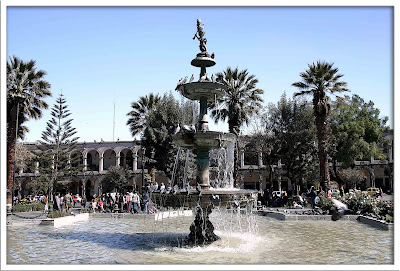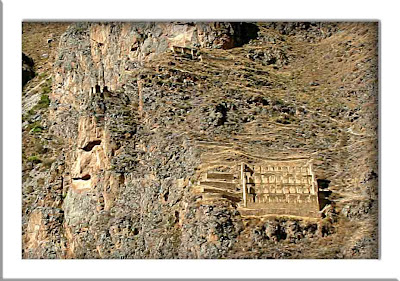Sunday morning,18th July in Cusco.Been a bit exhausted travelling up and down to Machu Picchu, but a good nights rest solved it. OK Cusco is the main city en route to Machu Picchu. This place is swarming with tourists with the center attraction being The Plaza de Armes, lined with restaurants,bars and shops. Originally known as Qosq'o, it was the capital city of the Incas. The Spanish destroyed it and build their own city on top of it. Shit, everywhere I have been the Spanish destroyed everything Inca. Missed Machu Picchu though.
Again cathedrals major attraction here in Cusco.
And a gringo pub called Norton's Bar.Our flag up there too - a little small though.
Thursday, 16th July left at 8 am for the Sacred Valley, once a major agricultural hub for the Incas. Also here two major archeological sites Pisac and Ollantaytambo.
A view of the Sacred Valley.Produce mainly corn and potatoes. Incas had a vast knowledge of agriculture and is known to have experimented with different crops at different altitudes.As you will see later, making their habitation up in the mountains, this was necessary.Today South America produces 3 000 different types of potatoes First stop was Pisac. I was happy to see that there were more stones than the other site I have been to.Did not have to stretch the imagination.
Everywhere you go to see Inca, you climb stairs and come down stairs. I have never climbed so many stairs in my life!These guys must have legs like tree stumps!
See what I mean living up at more than 3 000 meters above sea level.
These steppes, a feature of virtually every hill and mountain in Peru,are the farming area for the different produces.Soil is a mixture of soil from the mountain and soil from the Sacred Valley. The steppes also served as a water filtration system.
All construction here in Pisac consists of rock and a clay mix and all walls constructed to lean inwards. This was done in order to withstand earthquakes.
After that we left for Uramba, a town on the way to Ollytantambo, and had a buffet lunch. Guinea pig topped the meat list. Tasty! Yes, guinea pig is a big part of the diet here in Peru.
After lunch, back into bus and off to Ollytantambo.Below pictures from Ollytantambo.
More stairs! View of the farming steppes from below.
View of the mountain from the steppes.See the constructions on the right and middle of the mountain. Next to the construction in the middle( left), one can distinguish a face feature carved out of the mountain rock. I have enlarged the image in the photo below. Can imagine the guys below shouting - more to the left. Now more to the right. Ok, a little up now.
Awesome hey?
Partial completed wall of what was supposed to have been a Sun Temple. Work was apparently stopped as a result of the Spanish invasion. But looked at how they have shaped these rocks to fit on top of each other. Truly amazing.Also this was hard work. Stone were transported from a quarry 6 km away up the mountain side using a zig zag path. Popular theory is that it was pulled and pushed up using logs as rollers.
The ceremonial fountain in the courtyard.
Cute local girl
That completed the tour here and I was left behind to catch the train to Agua Calientes. With 3 hours to kill, I booked myself into the first floor of a restaurant overlooking the town square and drinking my favourite local beer, watched with amusement the traffic horror below. They were re paving the square and that meant only one small avenue in and out. Buses with tourists stuck for 45 minutes at a time with the sun going down and they still had to get to the site! One entrepreneurial women started selling kebabs to the stuck passengers.After 2 liters of beer, it was time to walk the 10 minute walk to the station. Met with a fairly long queue, but half an hour later, on the train and a 2 hour journey ahead. Arrived at Agua Calientes later than expected as a result of various train stops to allow the returning trains to pass.Met at station by my hostel delegate and another 5 minute walk I was home.Passing through the town square (yes every town and city in South America has a square) , there was dancing and music of a cultural nature.Very festive! Learned later that it was a celebration in honour of The Virgen Of Carmen, a festival that lasted from the 15th - 17th July annually. Check this link for more info. www.livinginperu.com/blogs/travel/283
Some photos from the festival
Agua Calientes is the overnight stay for Machu Picchu which is 25 minutes away via bus. a village really consisting of hostels and restaurants and a rip off. Also the ATM's ran out of money that afternoon.Luckily remembered a 100 dollars bill I stashed away for a rainy day which I could exchange for the local currency.That solved, it started raining and all I could think of - am I going to see anything of Machu Picchu? Went to bed at about 12 am and up at 4 am the next day to catch the bus to Machu Picchu.When I got to the terminal the queu was probably 500 people long. And still raining! Eventually us drenched souls got on to the buses and travelled up a wet gravel road. As we went further, the rain diminished and when we got to the entrance, only mist swirled around the peaks and valleys. Yippee. Here are the pictures - my original motivation to come to South America.

See how far you have to climb?
Ceremonial rock used in mummifying the dead.
Sacred rock
And then of course my Llama friends
Until later
































































